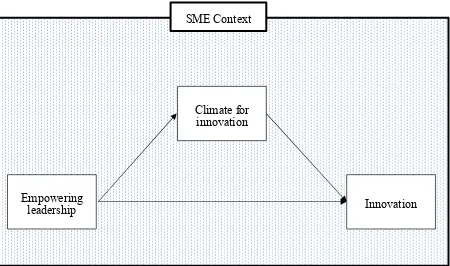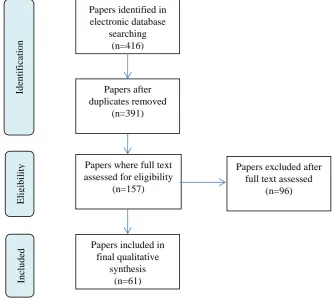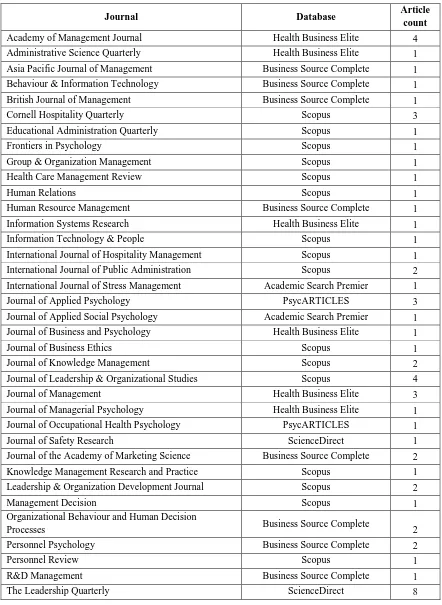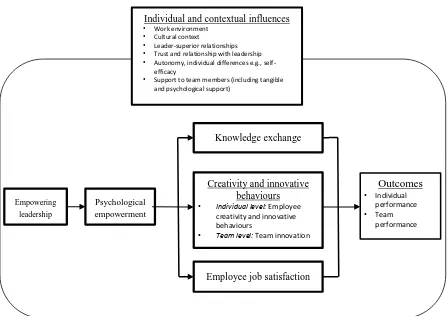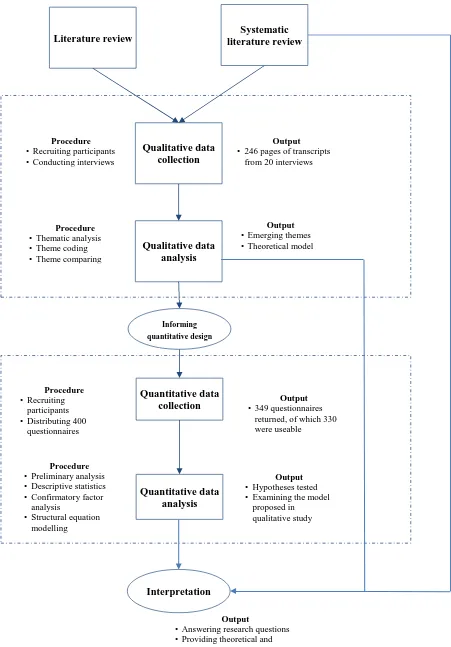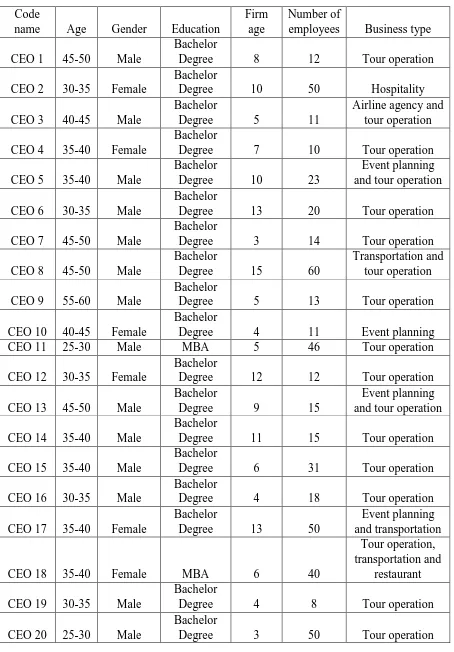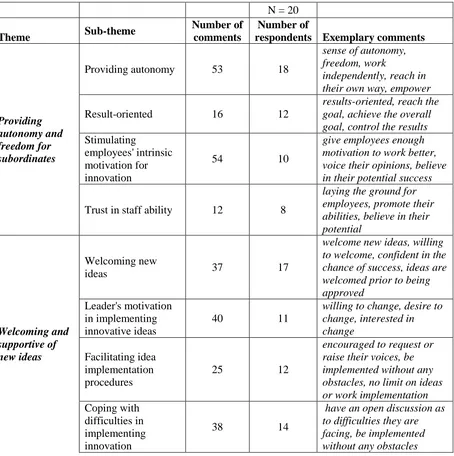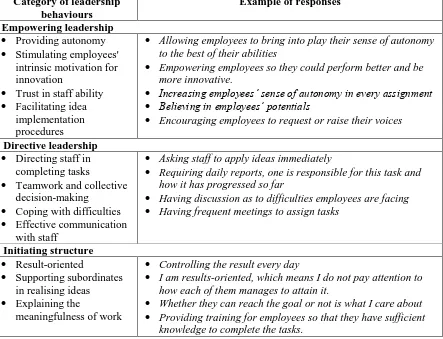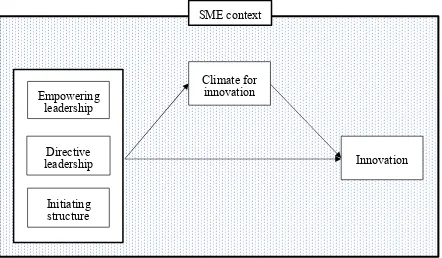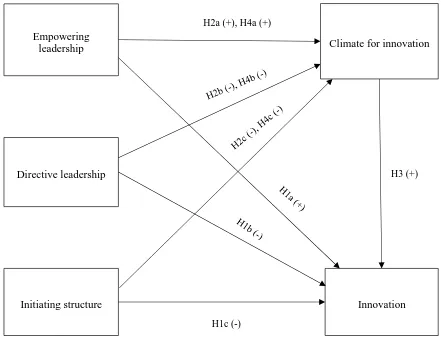Leading Innovation in Small and Medium-Sized
Enterprises: Understanding the Role of Empowering
Leadership and Organisational Climate
HOANG TRUONG GIANG
Bachelor of Business Administration, Foreign Trade University, Vietnam Master of International Law and Economics, University of Bern, Switzerland
Submitted in fulfilment of the requirements of the degree of Doctor of Philosophy
Victoria University Melbourne, Australia
ii
Student Declaration
I, Hoang Truong Giang, declare that the PhD thesis entitled “Leading Innovation in Small and Medium-Sized Enterprises: Understanding the Role of Empowering Leadership and Organisational Climate” is no more than 100,000 words in length including quotes and exclusive of tables, figures, appendices, bibliography, references and footnotes. This thesis contains no material that has been submitted previously, in whole or in part, for the award of any other academic degree or diploma. Except where otherwise indicated, this thesis is my own work.
iii
Table of Contents
List of Figures ... x
List of Tables ... xi
List of Publications ... xii
Abstract ... xiii
Chapter 1. Introduction ... 1
1. Introducing the study ... 1
2. Research problem ... 3
2.1 The relationship between empowering leadership and innovation ... 3
2.2 The mediating role of climate for innovation on the relationship between empowering leadership and innovation ... 4
2.3 Exploratory research on empowering leadership and innovation ... 4
3. Research aims and questions ... 5
4. Contribution and significance of the research ... 6
5. Context of the study ... 8
6. Thesis structure ... 9
7. Chapter summary ... 9
Chapter 2. Literature review ... 11
1. Introduction ... 11
2. Innovation... 11
2.1 Definition of innovation ... 11
2.2 Classification of innovation ... 12
2.3 Innovation in SMEs ... 13
3. Organisational climate... 14
3.1 The origins of organisational climate ... 14
3.2 Organisational climate and organisational culture ... 15
iv
3.4 Linking climate for innovation and innovation in SMEs ... 16
4. Leadership ... 19
4.1 Overview of leadership theories ... 19
4.2 Leadership in different cultures ... 23
4.3 Leadership in SMEs... 24
4.4 Leadership and innovation ... 25
4.5 Leadership and climate for innovation ... 27
4.6 Conceptual model of leadership, climate for innovation and innovation in SMEs .... 29
5. Chapter summary ... 30
Chapter 3. Empowering leadership, context and associations: A systematic literature review (SLR) ... 32
1. Introduction ... 32
2. The emergence of empowering leadership research ... 34
3. Method ... 35
3.1 Systematic literature review (SLR) ... 35
3.2 Search methods ... 36
3.3 Data analysis ... 39
4. Findings ... 39
4.1 Defining empowering leadership ... 39
4.2 Contexts for investigating empowering leadership ... 40
4.3 Assessing empowering leadership ... 41
4.4 Consequences of empowering leadership... 43
5. Discussion ... 50
5.1 Integrated framework ... 50
5.2 Future research agenda ... 52
5.3 Limitations ... 52
v
Chapter 4. Methodology ... 55
1. Introduction ... 55
2. Research paradigm ... 55
3. The rationale for mixed-methods research ... 57
4. Mixed-methods design approaches ... 59
5. Research methods ... 62
5.1 Qualitative research methods ... 62
5.2 Quantitative research methods ... 65
6. Ethics approval ... 66
7. Conclusion... 67
Chapter 5. Leaders influencing innovation: An exploration of the role of leadership and organisational climate within tourism SMEs ... 68
1. Introduction ... 68
2. Findings ... 69
2.1 Providing autonomy and freedom for subordinates ... 70
2.2 Welcoming and supportive of new ideas ... 72
2.3 Communication, inspiration and knowledge sharing ... 73
2.4 Teamwork and collective decision-making ... 74
2.5 Developing rewards and incentive systems ... 75
2.6 Comfortable working conditions ... 76
3. Discussion ... 77
4. Conclusion ... 81
Chapter 6. Leading innovation among tourism SMEs: Examining the mediating role of climate for innovation ... 83
1. Introduction ... 83
2. Hypotheses development... 84
2.1 Leadership and innovation ... 84
vi
2.3 Climate for innovation and innovation ... 89
2.4 The mediating role of climate for innovation ... 90
3. Preliminary analysis ... 91
3.1 Data screening and cleaning ... 91
3.2 Normality ... 91
3.3 Descriptive statistics ... 91
3.4 Common method variance ... 93
4. Results ... 94
4.1 Factor analysis ... 94
4.2 Tests of hypotheses ... 96
5. Discussion ... 98
6. Conclusion ... 99
Chapter 7. General discussion ... 100
1. Introduction ... 100
2. Answering the research questions ... 101
2.1.1 The influence of empowering leadership on innovation in SMEs (RQ1) ... 101
2.1.2 The role of empowering leadership in developing a climate for innovation in SMEs (RQ2) ... 102
2.1.3 Climate for innovation as a mediator in the relationship between empowering leadership and innovation in SMEs (RQ3) ... 103
3. Theoretical contributions... 104
4. Practical contributions ... 107
5. Limitations and future research ... 109
Summary ... 112
References ... 113
Appendices ... 142
Appendix 1: Ethics Approval ... 142
vii
Appendix 3: Consent form for interview participants involved in the research ... 146
Appendix 4: Interview protocol (in English) ... 148
Appendix 5: Interview protocol (in Vietnamese) ... 149
Appendix 6: Information to survey participants involved in the research ... 150
Appendix 7: Consent form for interview participants involved in the research ... 152
Appendix 8: Questionnaire (in English)... 153
Appendix 9: Questionnaire (in Vietnamese) ... 161
Appendix 10: Sample interview transcript coding screen in NVivo ... 168
viii
Acknowledgements
I had a ‘30 Before 30’ Bucket List and I am going to tick off an important item right before my 30th birthday: Completing a PhD. Reaching this point would not have been possible without the support and encouragement of many people. I would like to take this opportunity to thank them.
Firstly, I would like to express my sincere appreciation and gratitude to my principal supervisor, Professor Elisabeth Wilson-Evered. Choosing the ‘right’ PhD supervisor is one of the most important decisions I have made in my academic life. Elisabeth, you have been incredible, and I am grateful to have had you by my side during my PhD journey. Thanks for training me to become an independent researcher with a wide range of skills. You have been very patient answering my ‘ridiculous’ questions and you always reply to my emails in two seconds when I need your help. You are not only a talented scholar in leadership studies. You are truly a leader.
Special thanks to my co-supervisor, Associate Professor Leonie Lockstone-Binney. Thank you for your candid and constructive feedback on the numerous manuscripts and submissions prepared during this PhD. I must also acknowledge your contributions in reading my thesis in a very short period of time and providing valuable comments to improve it.
I have been very grateful to receive financial support via the Victoria University International Postgraduate Research Scholarship, Secomb Conference and Travel Scholarship, UNSW Business School Travel Grant and The Council for Australasian Tourism and Hospitality Education Bursary. These scholarships not only allowed me to focus full-time on my research and share this with others, but perhaps more importantly to help me see the world, which is another valuable form of education.
ix
Tien, Chip, Tuan and Tuan for talking to me after my work and making me laugh every day. Thank you Ms. Huong, Ms. Diep and Tuan for your invaluable translating assistance as well. I am also thankful to Dr Himanshu Shee at Victoria University for his statistical support and Dr Emma Curtin of Inkontext Writing, Editing and Research for her editorial services.
I am very fortunate to enjoy the support of my family in everything that I do. I dedicate the inspiration for this thesis to my Mother, who devoted her entire life to provide the best education for my sister and me. Mom, I just want to tell you that I finally made it. Your patience, sacrifices and enduring support throughout my life are the main motivation for me to complete this journey. Thank you for letting me fly. Many thanks to my lovely sister, brother-in-law, niece and nephew for being my support system throughout this process and for the many sacrifices they have made so that I could follow my dream.
x
List of Figures
Figure 1. Proposed relationship between empowering leadership, climate for innovation and innovation ... 29 Figure 2. Flow chart of paper search for the SLR on empowering leadership ... 37 Figure 3. An integrated framework for empowering leadership in organisational contexts .. 51 Figure 4. Stages of the research design ... 61 Figure 5. The proposed associations among leadership, organisational climate and
xi
List of Tables
Table 1. Database and journals included in SLR ... 38
Table 2. Themes of empowering leadership; antecedents, interactions and outcomes in organisational contexts ... 43
Table 3. Summary of participants in qualitative phase ... 63
Table 4. Themes, sub-themes, number of comments and number of respondents ... 69
Table 5. Leadership behaviours encouraging innovation in SMEs ... 78
Table 6. Participants’ demographics ... 92
Table 7. Means, standard deviations and correlation matrices ... 93
Table 8. Comparison of measurement models ... 95
xii
List of Publications
Peer-reviewed articleHoang, G, Wilson-Evered, E & Lockstone-Binney, L 2019, Leading Innovation among Tourism Small and Medium Enterprises: Examining the Mediating Role of Climate for Innovation, Leadership & Organization Development Journal (accepted on 08/07/2019, in press).
Articles under review
Hoang, G, Wilson-Evered, E & Lockstone-Binney, L, Manuscript submitted to Management Research Review (under review).
Hoang, G, Wilson-Evered, E & Lockstone-Binney, L, Manuscript submitted to Employee Relations (under review).
Refereed conference proceedings
Hoang, G, Wilson-Evered, E, Lockstone-Binney, L 2018, ‘Empowering leadership, context and associations: A systematic literature review’, British Academy of Management Conference 2018, 4-6September, Bristol, UK (Best Paper Award).
Hoang, G, Wilson-Evered, E, Lockstone-Binney, L 2017, ‘Linking leadership and innovation: A qualitative study of climate for innovation in tourism SMEs’, British Academy of Management Conference 2017, 5-7 September, Warwick, UK.
Hoang, G, Wilson-Evered, E 2016, ‘Exploring the relative contribution of empowering leadership and organisational climate to innovation in SMEs’, British Academy of Management Conference 2016, 6-8 September, Newcastle, UK.
Conference presentations
xiii
Abstract
1
Chapter 1. Introduction
1. Introducing the study
Innovation is considered an important factor in organisational effectiveness and competitive advantage (Slåtten & Mehmetoglu 2014). Organisations seek to be competitive through innovation and continuous improvement of products, processes or services in a competitive market (De Dreu & West 2001). According to Hart et al. (2002), innovation is a form of prosocial behaviour that has an essential impact on the success of an organisation. Typically, innovation is prioritised in organisational strategy to build competitive advantage and guarantee sustained economic survival (Cozijnsen, Vrakking & IJzerloo 2000; Hyland & Beckett 2004). Researchers have identified a range of factors affecting the innovation capability of firms; amongst these are leadership (Chan, Liu & Fellows 2014; Matzler et al. 2008) and organisational climate (West et al. 2003).
Research shows that different forms of leadership are related to innovation (Amabile et al. 2004; George & Zhou 2007). For example, a positive relationship exists between supportive leadership and innovation, and a negative relationship between controlling leadership and innovation (Amabile et al. 2004; Madjar, Oldham & Pratt 2002). In view of broader leadership approaches, empirical studies support the idea that transformational leadership has a positive effect on innovation (Jung, Chow & Wu 2003). Similarly, other leadership approaches have a positive impact on innovation, such as servant leadership (Yoshida et al. 2014), authentic leadership (Cerne, Jaklic & Skerlavaj 2013), and ethical leadership (Chen, A & Hou 2016). However, scarce attention has been paid to the link between innovation and empowering leadership, which is a leadership approach with the potential to influence innovation and creativity (Chow 2017; Zhang, X & Bartol 2010). In considering the evidence that empowering leaders may encourage innovation, scholars have called for a closer examination of empowering leadership and its influence on innovative work (Zhang, X & Bartol 2010).
2
transformational leadership (Liu, W et al. 2003). Given that leadership is described as a process of influencing others (Yukl 2010), to empower emphasises giving influence to, rather than having influence over, others or situations. Therefore, empowering leadership shows promise as a trigger for innovation, especially in the fluid, fast-paced and competitive tourism sector featuring creative individualism (Chow 2017; Hjalager 2010).
To encourage innovation, the contributing of an organisational climate for innovation has been identified (Isaksen & Akkermans 2011). Schneider, Ehrhart and Macey (2013, p. 362) described organisational climate as “the shared perceptions of and the meaning attached to the policies, practices, and procedures employees experience and the behaviours they observe getting rewarded and that are supported and expected”. An organisational climate that supports innovation is conceptualised as practices and norms that motivate employees to take initiative, and implement new ideas, processes, or products that benefit the organisations (West et al. 2003). Employees’ perceptions of a positive climate, which provides easy accessibility to organisational resources mediates the effects of leadership on employee creative performance (Scott & Bruce 1994). The presence of such a climate at the group level adds a facilitating edge to empowering leaders in promoting staff performance (Charbonnier-Voirin, El Akremi & Vandenberghe 2010; Jaiswal & Dhar 2015). However, the indirect effect of empowering leadership on innovation through climate for innovation has received less attention (Anderson, N & West 1998). To address this gap, this thesis explores the mediating role of climate for innovation on the relationship between empowering leadership and innovation.
3
and multinational corporations operating in Vietnam, which have demonstrated success through innovation. Following this trend, the importance of innovation escalated, demanding that SMEs in Vietnam create and sustain their competitive advantage by improving their innovation capabilities.
Although leadership effectiveness has been studied in a wide range of countries, the topic has been under-researched in Vietnam (Ralston, Nguyen & Napier 1999). Vo and Hannif (2013) argued that despite some similarities between Vietnam and its neighbouring countries, researchers should not assume that notions of leadership arising from other Asian or Western countries will equally apply to the business context of Vietnam. The economic transition in Vietnam over recent decades has generated further interest in leadership styles as a subject of analysis in the Vietnamese business context (Muenjohn & McMurray 2017; Quang, Swierczek & Chi 1998; Tran, D, Fallon & Vickers 2016). Therefore, a study unpacking the relationship between leadership and innovation in the context of Vietnam SMEs has implications for research and practice.
This thesis aims to examine how empowering leadership encourages innovation and enhances a climate for innovation in Vietnamese tourism SMEs. The research results are expected to make theoretical and practical contributions in the management field.
2. Research problem
The previous section discussed the increasing importance of the practice of managing innovation in SMEs. In this section, the research problems and research gaps in the literature are discussed in detail.
2.1 The relationship between empowering leadership and innovation
4
2.2 The mediating role of climate for innovation on the relationship between empowering leadership and innovation
This thesis integrates theoretical frameworks to examine the intervening role of climate for innovation on the relationship between empowering leadership and innovation. Despite the theoretical prediction that empowering leadership will be effective in different settings, some contextual variables are deemed to facilitate the effectiveness of empowering behaviours (Zhang, X & Zhou 2014). Leadership, which is considered a dynamic social process, does not happen in a vacuum. Instead, it is developed in an environment where leadership behaviours interact with contextual factors to become effective (Chan, Liu & Fellows 2014; Matić et al. 2017). Similarly, the contingency approach suggests that leadership is enabled by many potential mediators among which the organisational context is a strong contender (Dale & Fox 2008; Pigeon, Montani & Boudrias 2017; Shanker et al. 2017; Yoshida et al. 2014). Leadership behaviours are influential for shaping organisational climate and warrants scholarly attention in different contexts (Chen, A & Hou 2016; Shanker et al. 2017). To extend such understanding, this thesis explores the mediating role of climate for innovation on the association between empowering leadership and innovation in tourism SMEs.
The presence of a climate for innovation is expected to facilitate the effect of leadership by encouraging employees’ innovative behaviours to result in implemented innovation. A climate for innovation creates norms and practices, providing autonomy and encouraging employees to formulate new ideas (West et al. 2003). Employees working in a climate for innovation perceive they are empowered to think independently and build on their cognitive and emotional resources to contribute in a creative manner to the organisation’s objectives. Empowering leaders invite employees to build on their inner strengths and resources for individual and organisational benefit. Within a climate for innovation, employees interpret the actions of leaders as legitimate, supported and rewarded by the organisation. However, there is limited empirical evidence that climate for innovation mediates the relationship between empowering leadership and innovation (Matić et al. 2017; Xue, Bradley & Liang 2011). Therefore, this study will be the first to investigate the facilitating role of climate for innovation on the relationship between empowering leadership and innovation.
2.3 Exploratory research on empowering leadership and innovation
theoretical-5
based models. Very little exploratory research on this topic has been published. Therefore, an exploratory studies has the potential to develop deeper understandings of empowering leadership and its effect on innovation (Sharma & Kirkman 2015). This thesis makes an important contribution by conducting a mixed-methods study to develop a conceptual model highlighting the role of empowering leadership in encouraging innovation. This study uses a sequential exploratory research design, as suggested by Creswell (2014), to identify the variables and develop an integrated model through which to investigate the relationship among empowering leadership, climate for innovation and innovation. To address the research questions (discussed in the next section), this study was conducted in two phases. The first phase explored how Chief Executive Officer (CEO) report that their leadership behaviours shape the organisational climate of their organisations and how their leadership influences innovation. Next, a quantitative study was conducted to empirically test the model with a larger sample.
This research is one of the first studies investigating empowering leadership using mixed methods and it provides new insights on innovation in SMEs in a developing economy. By focusing on the mediating role of climate for innovation, the thesis provides improved understanding of the role of climate for innovation in the relationship between empowering leadership and innovation.
3. Research aims and questions
The aim of this study was to develop broader insight into the relationship between empowering leadership, climate for innovation and innovation in the SME context. In pursuit of this overall aim, three research questions were formulated as follows:
RQ1. To what extent does empowering leadership influence innovation in the SME context? (Systematic review, Qualitative study and Quantitative study)
RQ2. What role does empowering leadership play in developing a climate for innovation in the SME context? (Qualitative study and Quantitative study)
RQ3. What is the role of climate for innovation in mediating the relationship between empowering leadership and innovation in the SME context? (Qualitative study and Quantitative study)
6
the ways in which senior managers envision and conceptualise turbulence and complexity within their organisation.
After exploring characteristics of a climate for innovation and its leadership from leader perspectives, this study concentrates on the relationship between empowering leadership and climate for innovation. From this perspective, the second research question (RQ2) is intended to provide an empirical investigation of the role played by empowering leadership in developing a climate for innovation. As there is a gap in the literature on the impact of empowering leadership on a climate for innovation (Matić et al. 2017; Xue, Bradley & Liang 2011), this study explored leadership approaches among Vietnamese SMEs. The findings of the qualitative study were used to inform the quantitative research design and the conceptual model. Consequently, an expanded conceptual framework was tested in the quantitative study. Proceeding from the insight developed into particular relationships between leadership and innovation within the SME context, the final question (RQ3) of this study focused on the mediating role of climate for innovation on the relationship between empowering leadership and innovation. Moreover, to ensure the robustness of any identified potential relationships between empowering leadership and innovation performance, this question also enabled an investigation of the effects of other leadership styles that emerged from the qualitative findings. By doing so, this question provided an opportunity to analyse the leadership-innovation relationships in an SME context, thereby broadening the focus of the study to include other than empowering leadership behaviours.
4. Contribution and significance of the research
Whereas several studies have been conducted in the field of leadership and innovation in SMEs, this study is among the first to explore the influence of empowering leadership on innovation SMEs in an emerging economy.
7
also, in some circumstances, by instituting an initiating structure and directive approach.This thesis is among the first to study the link between theories of empowering leadership, innovation and climate for innovation as well as providing evidence of the linkages between initiating structure, climate for innovation and innovations to which some scholars have referred though few have empirically investigated (Gaudet & Tremblay 2017; Judge, Piccolo & Ilies 2004).
The study makes another significant contribution by proposing a grounded conceptual model reflecting the leadership process and its effects on organisational climate and innovation in SMEs. The findings from the mixed-methods study provide new insights into other leadership practices to provide autonomy for employees, enhance teamwork efficiency, and enable appropriate support for implementing new ideas. By suggesting the fine-tuning of leadership in the SME context, the thesis sheds light on those adaptive leadership strategies necessary to generate significant effects on the climate for innovation and on innovation itself; an identified gap in contemporary research evidence.
In practical terms, the findings have important implications for human resource managers seeking to improve creativity and innovation in firms. By developing a reward and incentive system along with leadership and team development programs, human resource specialists can help shape the suitable context for leadership behaviours that stimulate innovation in SMEs. The effects of such initiatives, on both policy development and implementation of appropriate human resource practices and systems, may help shape an organisational climate supportive of leadership for innovation. They may also facilitate resource flexibility and the intellectual capital essential for achieving and maintaining innovative behaviours. Moreover, human resource specialists may provide coaching, discussions, mentoring, or training in supporting employees to nurture new ideas and implement those ideas successfully.
8
climate for innovation and encourage innovative behaviours to enhance innovation in their organisations.
5. Context of the study
The context or setting in which the study is situated always influences research implementation and findings (Antonakis, Avolio & Sivasubramaniam 2003). An argument can be developed that management research requires contextualisation as it makes studies more precise and interpretation of findings more robust (Rousseau & Fried 2001; Schneider 1982). Contextual differences may cause inconsistent results, and teasing out underlying patterns requires researchers to focus more on the context (Rousseau & Fried 2001). This study was designed to control variability in the context and avoid extrapolating beyond the sample where the data were collected by selecting a single city (Hanoi), business sector (Tourism and SMEs) and cultural orientation (Vietnam).
The research was conducted on tourism SMEs in Vietnam. In this study, the current Vietnamese Government criteria for classifying a tourism firm as an SME was adopted. This is that an SME has no more than 200 employees (Government of Vietnam 2017). SMEs make a significant contribution in Vietnam, representing 97% of companies, employing 51% of the labour workforce and producing about 40% of GDP every year (Phan et al. 2015). Following this trend, the significance of innovation has been increasing, demanding that SMEs in Vietnam create and sustain their competitive advantage through improving their innovation capabilities.
The tourism sector also makes a significant contribution to the Vietnamese economy. According to the World Travel and Tourism Council, the direct contribution of tourism to the Vietnamese economy in 2017 was 9.4% of GDP and 4.6% of total employment (World Travel and Tourism Council 2018). This contribution is forecast to grow in both the short and long term (Martínez-Román et al. 2015). SMEs account for over 80% of Vietnamese tourism firms (Ministry of Culture Sports and Tourism 2014).
9
6. Thesis structure
This thesis includes a systematic literature review (SLR) and two empirical studies using mixed methods and involving both manager and employee samples. The thesis is structured as follows. This chapter (Chapter 1) has provided an overview of the topic, the research gaps that need to be addressed and the significance of the study.
Chapter 2 provides a brief exploration of the most important theoretical concepts used throughout the thesis. The purpose of the chapter is to present the underlying theoretical premises to answer the three sub-questions in the two chapters reporting the empirical studies (Chapter 5 and 6).
The SLR in Chapter 3 synthesises the current literature on the concept of empowering leadership and presents the contemporary empirical evidence on the link between empowering leadership and innovation.
Chapter 4 discusses the research design, analytic techniques, and the instruments used to measure the central concepts. Additionally, the methodological choices that were made are explained and discussed, with a focus on the reasons for, and implications of, combining both qualitative and quantitative methods.
Chapter 5 presents an analysis of the empirical data derived from managers of tourism SMEs in Vietnam. The qualitative study explores how leaders in tourism SMEs shape the organisational climate of their firms to enhance innovation. This chapter also presents the integrated model that informed the research design of the quantitative study.
Chapter 6 tests the study conceptual model and hypotheses with respect to empowering leadership and SME innovation performance, and explains the mediating role of climate for innovation.
Finally, Chapter 7 discusses the results of the empirical studies, thereby formulating answers to the research questions of this thesis. It also addresses the contributions and limitations of the research and presents theoretical and practical implications.
7. Chapter summary
10
11
Chapter 2. Literature review
1. Introduction
This chapter outlines omissions in the literature in relation to innovation, organisational climate and leadership in the SME context. First, an argument is developed by briefly reviewing relevant theories of innovation. In addition, an argument is presented for underlying the contribution of innovation in SMEs. Next, the chapter discusses the origins of organisational climate and the distinction between organisational climate and climate for innovation and organisational culture. The chapter also reviews relevant theories of leadership, cross-cultural leadership and leadership in the SME context. Subsequently, the differential impact of a number of leadership styles on innovation is explored. From this review, it is argued that empowering leadership potentially produces a climate for innovation among followers and encourages innovation. However, whether the influence of empowering leadership on innovation is direct or via a mediating mechanism has not been confirmed, and warrants further study. The review of literature in this chapter described theoretical frameworks which inform the empirical study reported in the following chapters. This chapter concludes by emphasising the needs to conduct an SLR on empowering leadership to identify how empowering leaders influence the climate for innovation and stimulate innovation.
2. Innovation
2.1 Definition of innovation
12
sustainability of innovations and the innovation life cycle; (3) diffusion of innovations; and (4) innovation and organisational performance.
Innovation comprises three interrelated activities: 1) idea formation, related to the generation of new ideas and the seeking of new methods, techniques, or instruments to advance knowledge and practice; 2) idea promotion that seeks to support innovative ideas and acquire approval for them; and 3) idea realisation, consisting of transforming innovative ideas into realisable applications (Janssen 2000; Kanter 1988; Scott & Bruce 1994). Innovation is often confused with creativity due to the complex nature of the two concepts. This confusion has been discussed in a number of studies (Amabile 1996; Cerne, Jaklic & Skerlavaj 2013; Ekvall 1996; West 2002; West et al. 2003), with recommendations to clarify the definitions of innovation and creativity. In their critical review, Hughes et al. (2018, p. 3) proposed the general definitions of creativity and innovation as follows:
Workplace creativity concerns the cognitive and behavioural processes applied when attempting to generate novel ideas. Workplace innovation concerns the processes applied when attempting to implement new ideas. Specifically, innovation involves some combination of problem/opportunity identification, the introduction, adoption or modification of new ideas germane to organisational needs, the promotion of these ideas, and the practical implementation of these ideas.
Of note, according to Hughes et al. (2018), creativity and innovation are conceptualised independently of any antecedents or potential effects. These definitions confirm that creativity and innovation in the workplace are two distinct but closely related concepts. Creativity refers to idea formulation, whereas innovation relates to the introduction, modification, promotion and implementation of ideas.
2.2 Classification of innovation
13
and process innovations. Research evidence suggests that a firm's competitive advantage depends on both product and process innovations (Chang, Bai & Li 2015; Damanpour & Evan 1984). Product innovation is seen in new outputs or services that are introduced for the benefit of customers and is considered the most critical factor contributing to a firm's competitive advantage (Casadesus-Masanell & Zhu 2012; Paladino 2008). Process innovation includes new tools, devices, and knowledge inputs that enable production and management operations (Chang, Bai & Li 2015). Based on these differentiating characteristics, Gopalakrishnan, Bierly and Kessler (1999) suggested that knowledge related to process innovation is more tacit and complex and therefore more difficult to understand and imitate than knowledge related to product innovation. By contrast, product innovation is often easier to understand and can be seen from the external environment (Von Hippel 1988).
2.3 Innovation in SMEs
Innovation has long been recognised as important for the development of firms of all sizes (Tucker 2002). Innovation motivates firms to implement better business solutions and brings the potential for greater future success (Hult, Hurley & Knight 2004). Scholars have indicated that innovation has a significant effect on the sustainability of firms’ competitive advantage (Barney 1991; Porter 1980). Innovation, therefore, reflects the firms’ ability to search and apply new and better ideas, practices or material artefacts to achieve improved performance and adaptability to market changes (Blumentritt & Danis 2006; North & Smallbone 2000).
14
ideas; they are receptive and flexible, especially in terms of viewing challenges as learning opportunities rather than obstacles (Noke & Hughes 2010).
A substantial number of theoretical and empirical studies have identified the link between leadership and innovation in large enterprises - although surprisingly few published works have drawn on the SME context (Jaiswal & Dhar 2015; Kenny, B & Reedy 2006; Muenjohn & McMurray 2016). The importance of leadership for innovative practice has been confirmed in SMEs in emerging economies (Al-Ansari, Xu & Pervan 2014; Muenjohn & McMurray 2017). Much is known about the drivers of innovation; however, there is limited research examining the perceptions of senior managers in enhancing innovation by shaping a climate for innovation (Herrera 2016).
3. Organisational climate
3.1 The origins of organisational climate
15
behaviours they observe getting rewarded and that are supported and expected”. In doing so, the definition developed by Schneider, Ehrhart and Macey (2013) draws on collective perceptions of individuals in relation to aspects of the organisation. In previous work, Schneider and Reichers (1983, p. 21) distinguished psychological climates and organisational climates by identifying that “psychological climates are the meanings an individual attaches to a work context, while organisational climates are the summated, averaged meanings that people attach to a particular feature of the setting”. In this thesis, the approach proposed by Glick (1985) and Schneider, Ehrhart and Macey (2013) is adopted by focusing on the climate for innovation that affects the operation and strategies of SMEs. The effort of the whole organisation is considered salient in creating an organisational climate that stimulates innovation in SMEs (Baer & Frese 2003).
3.2 Organisational climate and organisational culture
Both organisational climate and organisational culture are affected by leadership and can be instrumental in shaping innovation, so distinguishing between these two constructs is appropriate (Ekvall 1996). Organisational culture is defined as “the shared basic assumptions, values, and beliefs that characterise a setting and are taught to newcomers as the proper way to think and feel, communicated by the myths and stories people tell about how the organisation came to be the way it is as it solved problems associated with external adaptation and internal integration” (Schneider, Ehrhart & Macey 2013, p. 362). This values orientation sets culture apart from climate.
16
Organisational climate is considered one of the most important aspects in organisational settings as it affects organisational performance (Schneider, Ehrhart & Macey 2013; Zohar & Hofmann 2012). Organisational climate is the focus of the current study, seeking to empirically examine the mediating role of climate, rather than organisational culture, on innovation by understanding behaviours rather than values. The following section considers the characteristics of the climate for innovation.
3.3 Climate for innovation as a domain specific climate
Hunter, Bedell and Mumford (2007) identified that organisational climate is a domain referenced phenomenon that is specific to a context. In support of this idea, Schneider, Ehrhart and Macey (2013) argued that the concept of climate should be studied in a defining context. In the past decades, scholars have examined a number of specific domain climates, for instance, climate for innovation (Amabile 1996; West 1990), safety climate (Zohar & Luria 2005), climate for entrepreneurship (Bergmann et al. 2018), ethical climates (Joe et al. 2018; Wimbush & Shepard 1994) and climate for service (Schneider et al. 2009).
The current study focuses on innovation in SMEs, therefore, organisational climate will be understood as climate for innovation. Climate for innovation refers to “practices and norms supported by an organization that encourage employees to take initiatives, and explore and develop new ideas, processes, or products that benefit the organization” (Charbonnier-Voirin, El Akremi & Vandenberghe 2010, p. 701). According to psychological climate theory (Schneider, Brief & Guzzo 1996; Schneider, Ehrhart & Macey 2013; Schneider & Reichers 1983), employees tend to respond to the cognition of the environment rather than to an objective environment. Therefore, employees’ innovative behaviours are dependent on their perceptions of the environment. A climate for innovation is predicted to facilitate employees to adapt to changes and adopt innovative behaviours (Ekvall 1996; West et al. 2003; Wilson-Evered & Härtel 2001). In the following section, the relationship between climate for innovation and innovation is discussed in the context of SMEs.
3.4 Linking climate for innovation and innovation in SMEs
17
and organisational performance (Koene, Vogelaar & Soeters 2002; Schneider, Brief & Guzzo 1996). Innovation is dependent on a climate that supports innovation (Isaksen & Akkermans 2011). Although individuals could generate creative and innovative ideas by themselves, their willingness to innovate is contingent on the climate in which they work (Mumford et al. 2008). Innovative organisations typically have climates that support innovation, based on the number of patents achieved, technology development, business strategies and success in introducing new products and services to the market (Ekvall 2002), which differentiates them from stagnant or complacent organisations.
18
and colleagues with who they can exchange ideas, is critical to enable creativity and innovation” (Hunter, Bedell & Mumford 2007, p. 77).
The potential of various measures of climate for innovation to predict innovation and creativity has been studied (Mathisen & Einarsen 2004; Shanker et al. 2017). To assess the validation of such measures, researchers have investigated the relationship between climate dimensions and innovation outputs and outcomes (Bunce & West 1995; Caldwell & O’Reilly III 2003). Further, evidence for the predictive validity of climate assessment has been achieved using a variety of other criteria, comprising expert judgments of products produced (Agrell & Gustafson 1994), innovation adoption (Kitchell 1995), and engagement in entrepreneurial activities. Clearly, a climate measure can provide perceived evidence of innovation but has more weight if perceptions can be translated to actual innovation outcomes (Isaksen & Akkermans 2011). Several empirical studies have focused on the relationship between climate, innovation and other organisational factors such as leadership and firm performance. Hosseini, Azar and Rostamy (2003) used structural equation modelling (SEM) and path analysis to analyse data collected from 158 middle managers from 96 manufacturing Iranian companies. Their study concluded that organisational climate mediated the relationship between middle managers’ technological innovation and organisational factors, including organisational structure, strategies and working environment. Furthermore, a study of 47 German medium-sized enterprises indicated that climates for initiative and psychological safety were significantly associated with firm performance and moderated the relationship between firm performance and process innovation (Baer & Frese 2003).
19
European countries the links between factors of the climate for innovation and individual meaning of work and job satisfaction were excluded from the model. The authors suggested future research should evaluate the application of the findings in other contexts, particularly in developing countries (Übius, Alas & Elenurm 2013).This suggestion is congruent with the aims of the current study.
Organisations having successfully developed climate for innovation to create policies and practices that welcome the expression and implementation of new ideas (Charbonnier-Voirin, El Akremi & Vandenberghe 2010). An organisation supporting innovation plays an important mediating role in stimulating innovative behaviours (Cerne, Jaklic & Skerlavaj 2013). In sum, individuals working in a workplace with a climate that values experimentation and tolerates occasional flaws, exhibit higher levels of creative behaviours (Jaiswal & Dhar 2015). In line with the findings of previous studies, Wang, P et al. (2013) found that a climate for innovation predicted innovation more significantly when the climate for innovation strength was high.
Previous studies have identified that developing a suitable climate for innovation will enhance the innovation capacity of SMEs (Kmieciak, Michna & Meczynska 2012; Popa, Soto-Acosta & Martinez-Conesa 2017). It is important to understand the contribution of senior leaders, who are often the owner of the firm, and their perceptions of how they create a climate to encourage innovation (Mazzarol et al. 2014). Further studies are necessary to explore the deep insights of SME leaders in terms of how they shape the climate for innovation through, for example, idea sharing, trust, creativity stimulation, support for innovation, and openness to change (Scott & Bruce 1994). By incorporating the theoretical views and empirical evidence, the current study proposes that climate for innovation enhances innovation in SMEs.
4. Leadership
4.1 Overview of leadership theories
20
(Kozlowski et al. 2009) and as critical for enterprise innovation. Matzler et al. (2008) concluded that leadership had a strong influence on firm performance and innovation. Given the extant evidence to link innovation and leadership, the current study focuses on the role of leadership in stimulating the emergence of a climate for innovation and its direct and indirect effect on innovation.
Gardner et al. (2010) provided a detailed description of the development of a leadership theory classification scheme. This scheme consisted of 29 categories of leadership theories. Some examples are the complexity theory of leadership, cross-cultural leadership, behavioural approaches, and leadership traits and attributes. Relatively recently, Dinh et al. (2014), based on the work of Gardner et al. (2010), conducted a systematic review of leadership theory trends. Dinh et al. (2014) identified how much the leadership field has developed in recent decades and categorised 66 different leadership theory domains. Their classification showed that since the year 2000, a number of emerging leadership theories have developed in the literature, such as neurological perspectives on leadership and the continued explosion of theories relating to leading for creativity and innovation, toxic/dark leadership, and strategic leadership (Dinh et al. 2014). Moreover, findings suggested that scholars remain interested in some established leadership theories, such as neo-charismatic, information processing, trait, and leader–follower exchange theories. By contrast, there is less interest in leadership theories such as behavioural approaches, contingency theory, and path-goal theory. Generally, Dinh et al. (2014) concluded that the expansion of leadership theories shows the significance of developing and exploring this field of study.
21
Over recent decades transformational leadership has been studied in relation to innovation. Scholars (Podsakoff et al. 1990; Reuvers et al. 2008; Yukl 2010) sought to streamline and integrate various approaches to leadership, using the transformational theory formulated by Bass (1985). Bass recognised two forms of leadership: transformational and transactional. Transformational leadership, as theorised by Bass (1985), originated from the classification of political transformational and transactional leaders proposed by Burns (1978). In transactional leadership, the relationship of leader-subordinate is developed through bargaining and exchanges between both parties (Howell & Avolio 1993). In transformational leadership, leaders go beyond rewarding for achievement by idealising influence, individualising consideration, intellectually stimulating and inspirationally motivating followers to exceed their personal interests to achieve better collective goals (Bass 1985; Hater & Bass 1988). Such leadership behaviours are considered more complex than constructive and corrective transactions and are crucial to stimulate innovation.
22
in specific circumstances. Their findings suggest that leaders should sometimes direct and sometimes empower their followers, an approach which informs the current study.
Situational leadership theory introduced by Hersey and Blanchard (1969) has recently been reaffirmed as consisting of a set of perspective principles (Blanchard 2018). The original theory proposed a taxonomy of four leadership approaches - directive, coaching, supportive and empowering - and a framework to match each approach with particular circumstances (Blanchard 2018). New employees or learners who have high commitment but low competence would benefit from directive leadership with low supportive and high directive behaviours. For disillusioned learners who have low competence and low commitment, coaching leadership with high supportive and high directive behaviours would be appropriate. For capable but cautious employees, characterised as highly competent but with variable commitment, supportive leadership with high support and low directive behaviours is considered the best approach. Self-reliant performers, characterised by high competence and commitment, benefit most from empowering leadership with low directive and low supportive behaviours. While widely understood, situational leadership theory is surprisingly under-researched. This is due, in part, to difficulties associated with measurement, content and research design within the theory (Thompson & Glasø 2015, 2018).
In sum, the research reviewed in this section suggests that the study of leadership has continued to grow rapidly over past decades, attracting the attention of scholars and practitioners worldwide which has diversified the way the leadership phenomena is understood (Gardner et al. 2010). Leaders can develop their own theory of leadership to apply in particular situations. Empowering leadership is a distinct form of leadership, which theoretically could stimulate innovation. Comparing the evidence reviewed, the tenet of this thesis is that empowering leadership has an important place in contemporary research on innovation. However, a review of the literature on what is distinct about empowering leadership and its connection to innovation warrants objective analysis. Therefore, an SLR on empowering leadership was conducted and reported in Chapter 3, which provides further insights into this approach to leadership.
23 4.2 Leadership in different cultures
Cross-cultural studies of leadership has become a specialised field of leadership study (Gonzalez 2008; Hofstede 1976). Leadership behaviours are generally agreed to be common across cultures, though cultural contingencies at both the national and organisational levels deserve further scholarly attention (House & Javidan 2004). Since the 1960s, research on cross-cultural leadership has grown in both quality and quantity; although gaps remain. First, most of the leadership theories and practices are based on Western concepts and assumptions about human behaviours (Li et al. 2015; Muenjohn & McMurray 2017; Tajasom et al. 2015; Tran, D, Fallon & Vickers 2016). Challenges exist in the transferability of such models to other business environments, given differences in context (e.g., historical, institutional, and cultural backgrounds), which significantly affect attitudes and behaviours (Hawkins & Edwards 2014). Further, the applicability of a leadership style developed from a Western perspective to other contexts, including Asia, requires richer exploration (McDonald 2012). Second, previous studies of leadership styles are often conducted in a stable cultural context. Hofstede (1997) proposed that culture is difficult to change. Nevertheless, evidence from transition economies, including Vietnam, indicate that major economic shocks bring about important changes in societies and cultures over several decades (Vo & Hannif 2013). Indeed, Gamble (2001) investigated the transferability of the British flat hierarchical structure into Chinese society and argued that both culture and leadership styles should be perceived as adaptable and subject to change.
24
business context. Crises involving clashes of cultures, such as wars in recent decades, have likely had cultural impacts (Karsner 2013).
4.3 Leadership in SMEs
In any organisation, the importance of leadership in SMEs is unequivocal (Chen, G & Bliese 2002). In SMEs, the entrepreneur or business person who owns and/or manages an SME is usually the most influential decision-maker within the firm (Yan, L & Yan 2013). SMEs, particularly those led by owner-managers, typically have uncomplicated operational structures, a small number of staff, and bounded business activities (Mintzberg 1979). The business strategies of SMEs mostly reflect the objectives and ambitions of the owner (Covin & Slevinm 1989). This observation was confirmed by Miller (1983), who stated that the leadership style of the entrepreneur, including characteristics and decision-making style, often determines the innovation practices of SMEs.
25
In the subsequent sections, the relationship between leadership and innovation, and the relationship between leadership and climate are further described.
4.4 Leadership and innovation
The importance of leadership in supporting innovation (Hughes et al. 2018; Newman et al. 2018) is well-established. Leadership supports innovation when it motivates subordinates to work collaboratively to achieve common organisational objectives (Vroom & Jago 2007). Leaders of organisations are responsible for the performance of organisations and influence staff through decision-making and priority-setting (Isaksen & Akkermans 2011).
Analysing leadership for innovation is more specific than considering leadership in a general purpose context (Mumford & Licuanan 2004). Previous studies have examined the role of leadership in supporting and obstructing innovation. Based on a literature review and in-depth interviews with managers and entrepreneurs from a small knowledge-intensive service enterprise, De Jong and Den Hartog (2007) recognised 13 relevant leadership behaviours that motivate innovative behaviour among subordinates, both via their purposeful actions intended to encourage idea generation. The findings showed that six behaviours were believed to relate to only one type of innovative behaviour. These were intellectual stimulation, stimulating knowledge diffusion, organising feedback, rewards, providing resources, and task assignment. The other behaviours of innovative role-modelling, providing vision, consulting, delegating, support for innovation, recognition, and monitoring, were found likely to affect both idea generation and application behaviour (De Jong & Den Hartog 2007).
26
innovation is characterised by intellectual stimulation along with providing feedback, resources, challenges and task clarity.
Contemporary leadership theories suggest different pathways and outcomes of particular leadership styles on innovation. Leadership operates within various work conditions, ranging from distributing responsibilities to create autonomy to providing close and supportive direction and supervision of work. Drawing on path-goal (House & Mitchell 1974) and empowerment (Kirkman & Rosen 1999; Spreitzer 1995) theories, scholars have attempted to compare the effects of empowering leadership and directive leadership on employee innovative behaviours and creativity (Lorinkova, Pearsall & Sims 2013; Martin, Liao & Campbell 2012; Sims, Faraj & Yun 2009).
At the individual level, empowering leadership was found to affect employee creativity and innovation by stimulating psychological empowerment (Amundsen & Martinsen 2015; Zhang, S et al. 2018; Zhang, X & Bartol 2010). At team and organisational levels, leaders attempt to allocate responsibility, stimulate self-problem-solving and include followers in decision-making processes that were found to enhance empowerment and further increase innovation and creativity (Hon & Chan 2012; Kirkman & Rosen 1999).
In contrast, directive leadership focuses on giving detailed guidance and excluding followers from decision-making processes (Lorinkova, Pearsall & Sims 2013). Directive leaders usually provide less freedom and autonomy to subordinates than that provided by empowering leaders. Although superiors’ directiveness has been found to facilitate subordinates’ task accomplishment processes with specific directions, directive leadership tends to reduce individual creativity and discourage innovation (Lorinkova, Pearsall & Sims 2013; Martin, Liao & Campbell 2012). However, Sims, Faraj and Yun (2009), drawing on situational leadership theory and empirical evidence, argued that directive or empowering leadership can be optimised in specific situations and, in some circumstances, a combination of both approaches may be needed to nurture innovation.
27
instruction and frequent feedback. In such cases, directive leadership may stimulate innovation. Therefore, Sims, Faraj and Yun (2009) concluded that the influences of empowering leadership and directive leadership on innovation and creativity warrant further study.
An exploration of the extant literature revealed that the evidence for the relationship between empowering leadership and innovation in the context of SMEs is limited. However, due to the flat structure of, and the close leader-subordinate relationship in, SMEs, empowering leadership theoretically offers the enabling mechanisms to encourage innovation (Arnold et al. 2000; Sharma & Kirkman 2015). SMEs usually have uncomplicated operational structures, a small number of staff, and bounded business activities (Mintzberg 1979). A study of SMEs in the manufacturing sector in Malaysia found that empowering leadership positively related to knowledge sharing in SMEs (Eze et al. 2013). These scholars argued that employees in SMEs are motivated to share their knowledge and learn from co-workers when they receive reasonable recognition from their empowering leaders, allowing them to become more innovative (Eze et al. 2013). Similarly, findings from SMEs in the electronics and engineering sectors has shown that empowering leadership was significantly associated with innovation (O'Regan, Ghobadian & Sims 2006). By integrating theoretical views of empowering leadership and innovation, the current study argues that empowering leaders promote and encourage innovation in SME settings by enabling autonomy, providing coaching, support, goal clarity and resources.
4.5 Leadership and climate for innovation
28
Scholars have established the link between leadership and climate formation. During the 1990s and 2000s, when transformational theory was in its ascendency, transformational leadership was found to have a direct and positive association with, and support for, innovation as well as a direct and positive link with climate for innovation (Jung, Chow & Wu 2003). Jaiswal and Dhar (2015) studied dyads of 372 employees and their direct supervisors and similarly found that transformational leaders contributed to promoting a climate for innovation that stimulated creativity among employees. In sum, this body of research points to the importance of particular leader behaviours in encouraging innovation. These include a leader’s transformative approach, which is supportive of a climate for innovation, and his/her ability to perform creatively. An exploration of the link between leadership and climate for innovation in Australia by Sarros, Cooper and Santora (2008) applied latent variable SEM analysis to date from a sample of 1,158 Australian managers using the measure of climate for innovation developed by Scott and Bruce (1994). These authors reported that articulating a vision and providing individual support, as two facets of leadership, were strongly related to climate for innovation, which was operationalised using the support for innovation and resource supply measures developed by Scott and Bruce (1994).
29
develop cognitions and emotions that contribute in an innovative manner to their organisation’s objectives (Charbonnier-Voirin, El Akremi & Vandenberghe 2010). Therefore, from the foregoing review, empowering leadership is expected to positively influence a climate for innovation in the SME context.
4.6 Conceptual model of leadership, climate for innovation and innovation in SMEs
By integrating the theories of leadership, climate for innovation and innovation, this research proposes that empowering leaders promote a climate for innovation and encourage innovation in the SME context. This logical conclusion is theoretically determined in that empowering leaders provide autonomy and involve subordinates in decision-making processes. As indicated above, when they experience a climate for innovation, empowered employees think independently, making contributions in an innovative manner to their organisation’s objectives. Together, the theories of leadership and climate for innovation provide the framework for establishing a theoretical link between empowering leadership and innovation in the SME context. The proposed conceptual pathway for the empowering leadership-innovation process is illustrated in Figure 1.
Figure 1. Proposed relationship between empowering leadership, climate for innovation and innovation
Innovation Empowering
leadership
30
The model in Figure 1 illustrates the potential role of climate for innovation in mediating the relationship between empowering leadership and innovation. A review of the literature revealed that empowering leaders tend to develop an environment in which employees adapt to changes and adopt innovative behaviours. This interaction, in turn, contributes to stimulating innovation.
Although leadership behaviours are common across cultures, cultural contingencies at both the national and organisational levels may diversify the research results (House & Javidan 2004). An exploration of the literature revealed that leadership effectiveness is under-researched in the context of Vietnam. Consequently, the applicability of an empowering leadership approach developed from a Western perspective to the Vietnamese context requires further exploration (Quang, Swierczek & Chi 1998). The SLR reported in the next chapter examines the concept of empowering leadership, the contexts of empowering leadership studies and the association between this leadership construct with other factors, including innovation. The discoveries from the literature reviewed in this chapter and in the SLR are enhanced by the qualitative phase, which collated the insights of Vietnamese SME leaders on the leadership-innovation process. Discussion then focusses on determining how and to what extent Vietnamese leaders empower their subordinates’ innovative thinking. Thereafter, the findings from the qualitative phase are used to inform the conceptual model tested in the quantitative study.
5. Chapter summary
This chapter discussed the concepts of innovation, organisational climate, and leadership as adopted in this thesis. As the context of this study is SMEs, this chapter has also discussed these concepts in relation to the unique features of SMEs. Studies on the factors affecting the management of innovation in SMEs demonstrate connections between empowering leadership, climate for innovation and innovation. Brief consideration was given to the research on leadership and innovation in Vietnam. The review of literature in this chapter identified a number of knowledge gaps and described theoretical frameworks which inform the empirical study reported next.
31
32
Chapter 3. Empowering leadership, context and
associations: A systematic literature review (SLR)
1. Introduction
This chapter presents a systematic review of empowering leadership, which is connected to innovation through the creation of autonomy among followers and has attracted the increasing interest of scholars and practitioners. Consistent with the general leadership concept discussed in Chapter 2, particular attention is paid to empowering leadership and its association with innovation in organisational contexts. Situated in the broad field of leadership, this SLR takes a behavioural science perspective to examine current research on empowering leadership and its influences on others’ behaviour. Despite a number of different definitions (Yukl 2010) and methodologies used to investigate leadership (Mumford et al. 2008), the topic continues to engage readers (Chen, G & Bliese 2002). Empowering leadership is important to review in depth because of its focus on enabling others towards improvement and innovation.
33
where sharing power and decision-making is important and its application is worthy of ongoing study (Cheong et al. 2016; Lorinkova & Perry 2017; Martin, Liao & Campbell 2012).
Whereas writing on the notion of empowerment extends back to the 1980s, increasing interest in leadership is evident through the 60 or so empirical studies published over the last decade, which focus specifically on empowering leadership. However, despite scholarly attention (Fong & Snape 2015; Srivastava, Bartol & Locke 2006; Tuckey, Bakker & Dollard 2012; Zhang, X & Bartol 2010), the integration of findings through an SLR is timely. This chapter provides a synthesis of the relevant theories and identifies where, when and how empowering leadership has been empirically studied. The search located just one prior review of the extant literature on empowering leadership, written by Sharma and Kirkman (2015), which focused on the origin of its less positive effects in organisations using a sample of studies published before 2013. Their study set a useful agenda for future research on empowering leadership; however, what was lacking was a description of when and how empowering leadership had been studied and its correlates and consequences. Since the Sharma and Kirkman (2015) review, more than 20 empirical studies on empowering leadership have been published up until 2018, creating the potential to extend understanding of this leadership construct. In this chapter, the SLR method is used to determine the scope and findings of empirical studies, and to appraise the measures, results, and influence of empowering leadership. From this point, a renewed research agenda is proposed.
34
2. The emergence of empowering leadership research
The period from the 1980s onwards saw growth in recognition of the notion of empowerment as a concept to encourage employee engagement and productivity (Bartunek & Spreitzer 2006). This period featured rapid technological and commercial advances across all sectors (Fernandez & Moldogaziev 2011). Increased empowerment was justified as a means of improving customer-focused orientation, greater flexibility, flattened structures with decentralised decision-making and enhanced efficiencies (Amundsen & Martinsen 2015). Work roles and tasks simultaneously required higher levels of complexity and increased cognitive demands on workers (Humphrey, Nahrgang & Morgeson 2007). Highly skilled and educated knowledge workers play a crucial role (Parker, Wall & Cordery 2001), driving employees to contribute to work decisions, particularly how work should be designed and executed.
The changing landscape in work and empowerment took place in tandem with the emergence of empowering leadership (Pearce et al. 2003). Employee empowerment occupies the central tenet of the theory, which aims to encourage individual inspiration in the workplace through assigning duties and authority to the relevant organisational level (Conger & Kanungo 1988). Accordingly, Vecchio, Justin and Pearce (2010) defined empowering leadership as a leadership behaviour that shares power with followers.
